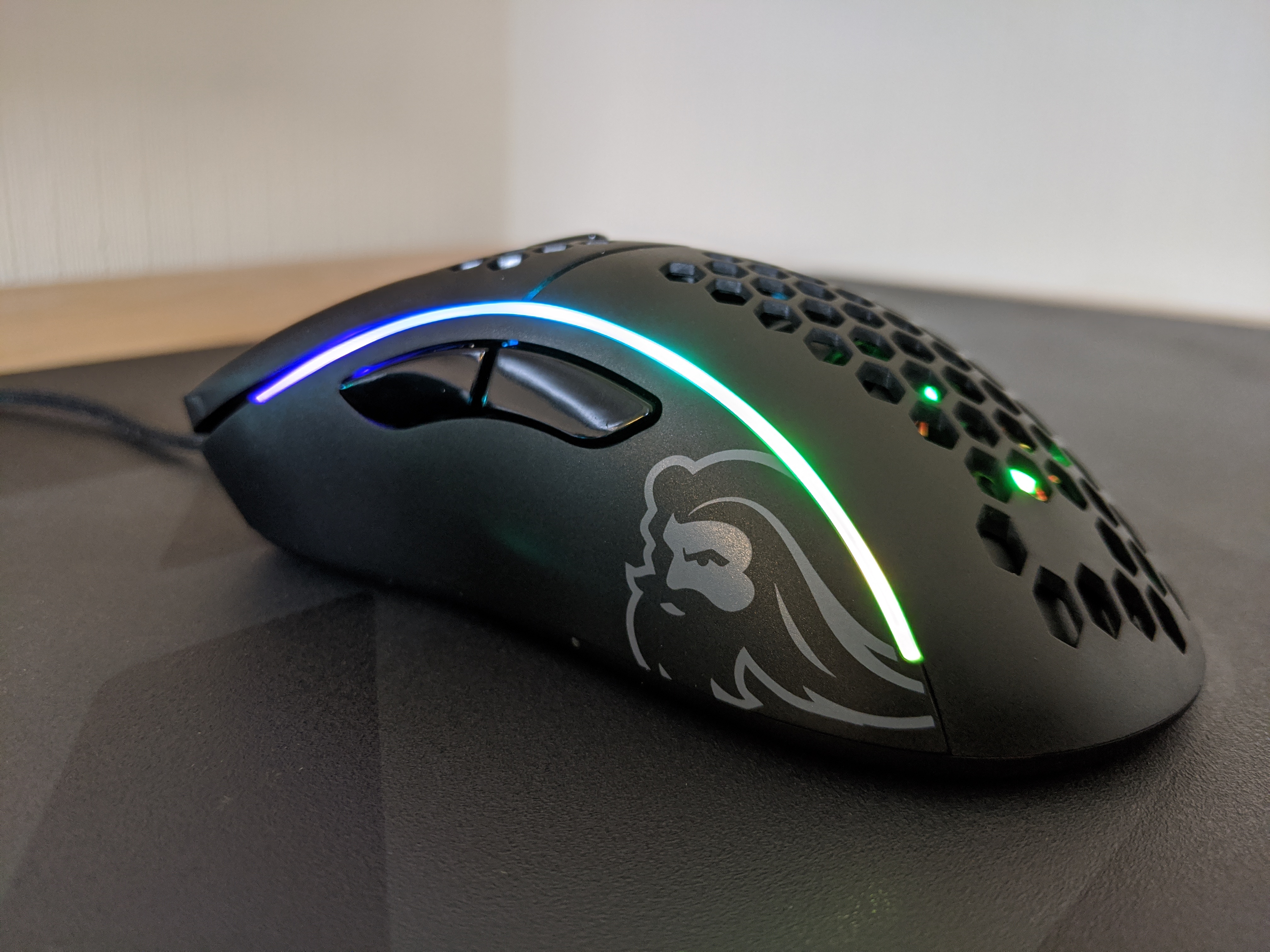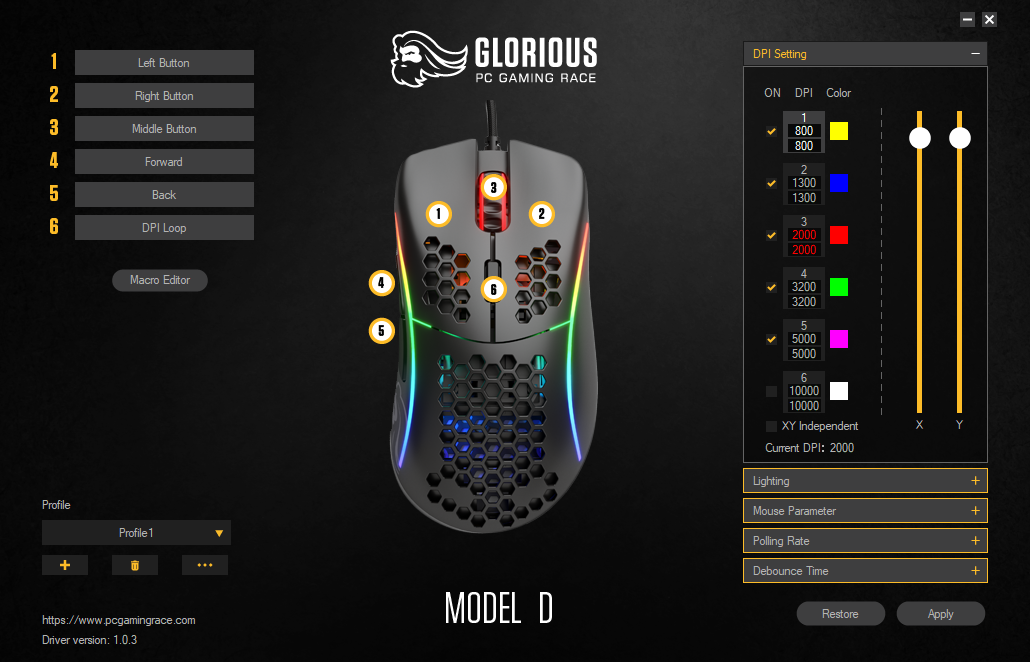Tom's Hardware Verdict
The Model D is great for anyone interested in competitive shooters and battle royales. But its software needs to be fixed.
Pros
- +
Helpful lightweight design
- +
Improved cable
- +
No lateral movement on left or right mouse buttons
- +
A real joy in shooters
Cons
- -
Less versatile than the Glorious Model O
- -
Too few buttons for some game types
- -
DPI indicator is useless on the underside
Why you can trust Tom's Hardware
Glorious may be the best peripheral manufacturer not on your radar. It seeks to make the best gaming mice and best gaming keyboards with ultra-lightweight skeletal frames for the former and modular designs for the latter. If you can put the branding out of your mind, which is inspired by subreddit and its iffy “master race” banter (and to be honest I’m just barely managing to do so), there’s a lot to love. Its offerings are also priced competitively and trim away the bloat, both in terms of features and timber, you might find lumbered to a rival model.
For those who like lightweight gaming mice, the Glorious Model D shines at just 68g (0.15 pounds) for our matte version and 69g for the glossy one. Glorious also makes the $50 Model O Minus (starting at 58g), and the zippiness of these skeletal models padded with large, high-quality PTFE feet feels inherently right in twitch-shooting situations. However, our review subject offers a different feel and cable than the O Minus.
Available for $49/£49, the Model D is an incredibly well-priced mouse considering the specs and performance. Only Razer’s Deathadder Essential, Corsair’s M65 Pro and Steelseries Rival 110 offer credible competition below this price, and all those feel pared-back in comparison to the Model D. When it comes to shooters. the Model D should be a serious consideration given its price and performance.
Glorious Model D Specs
| Sensor Type | Optical |
|---|---|
| Sensor Model | PixArt PMW3360 |
| Sensitivity | 12,000 CPI |
| Polling Rate | 1,000 Hz (1ms) |
| Lift-off Distance | ~0.7mm |
| Programmable Buttons | 6 |
| LED Zones | 3 programmable RGB |
| Cable Length: | 6.5 feet (2m) |
| Measurements (LxWxH) | 5.04 x 2.4 x 1.65 inches (128x61x42mm) |
| Weight | Matte version: 0.15 pounds (68g) |
Design and Comfort
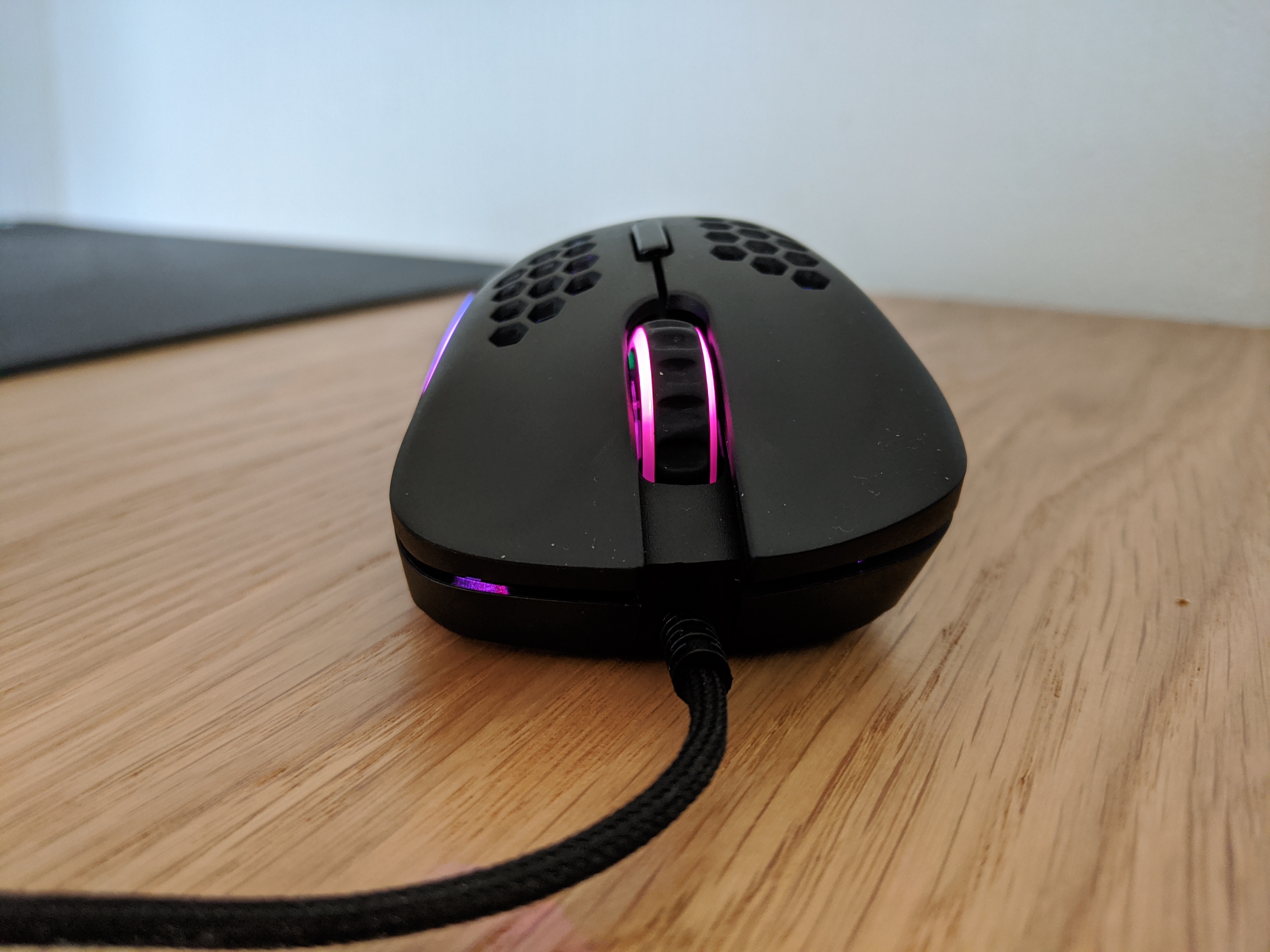
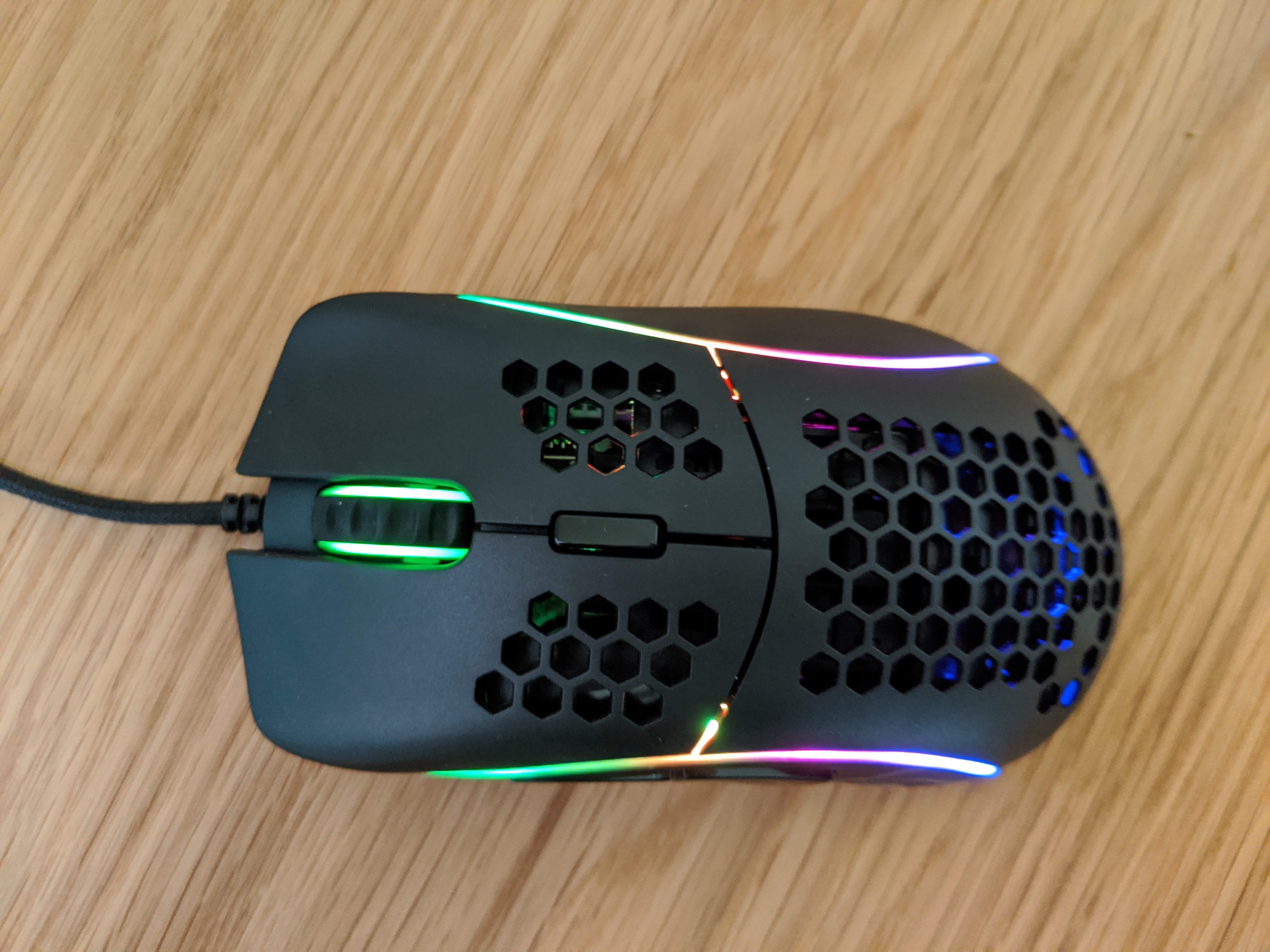
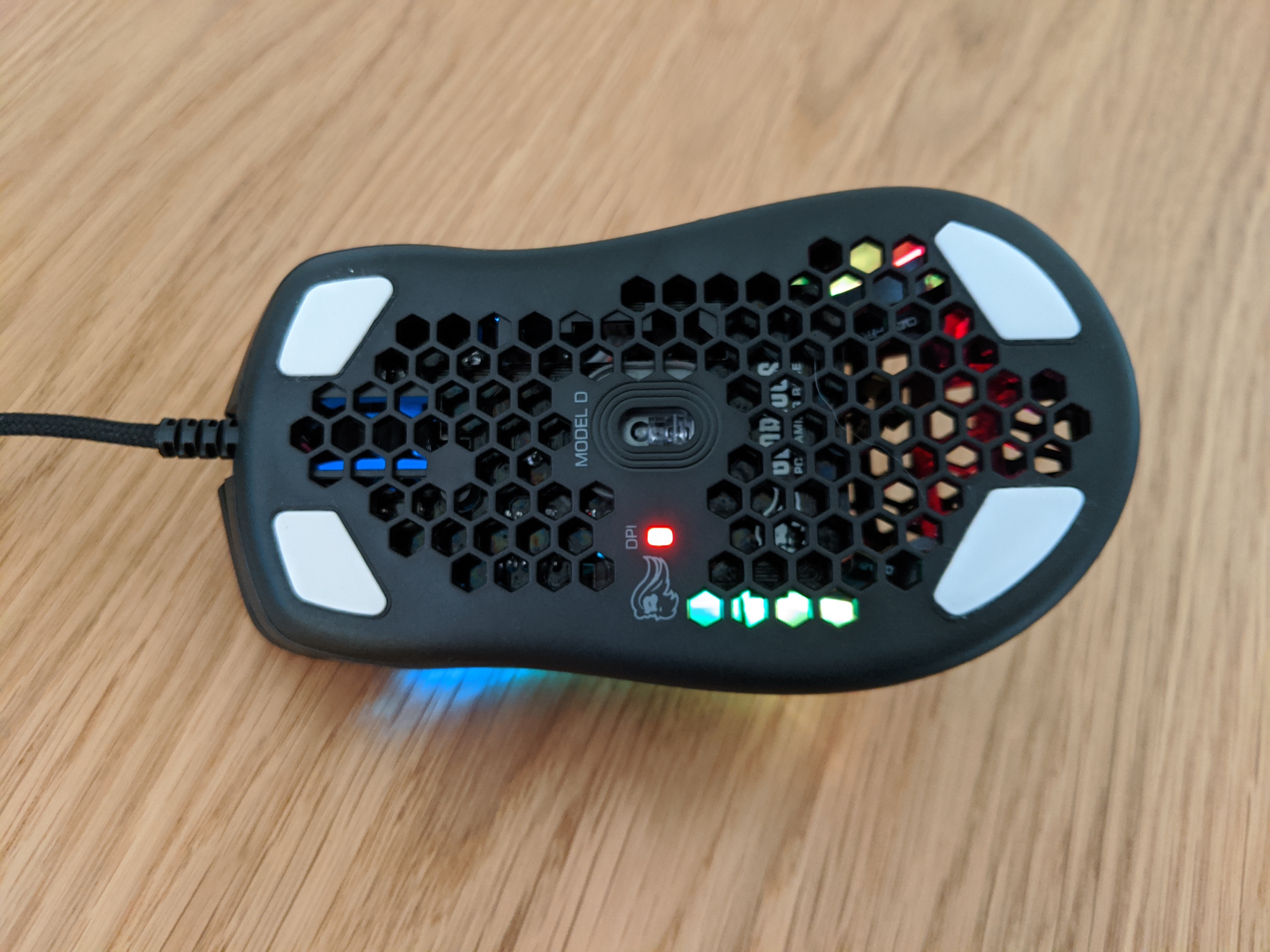
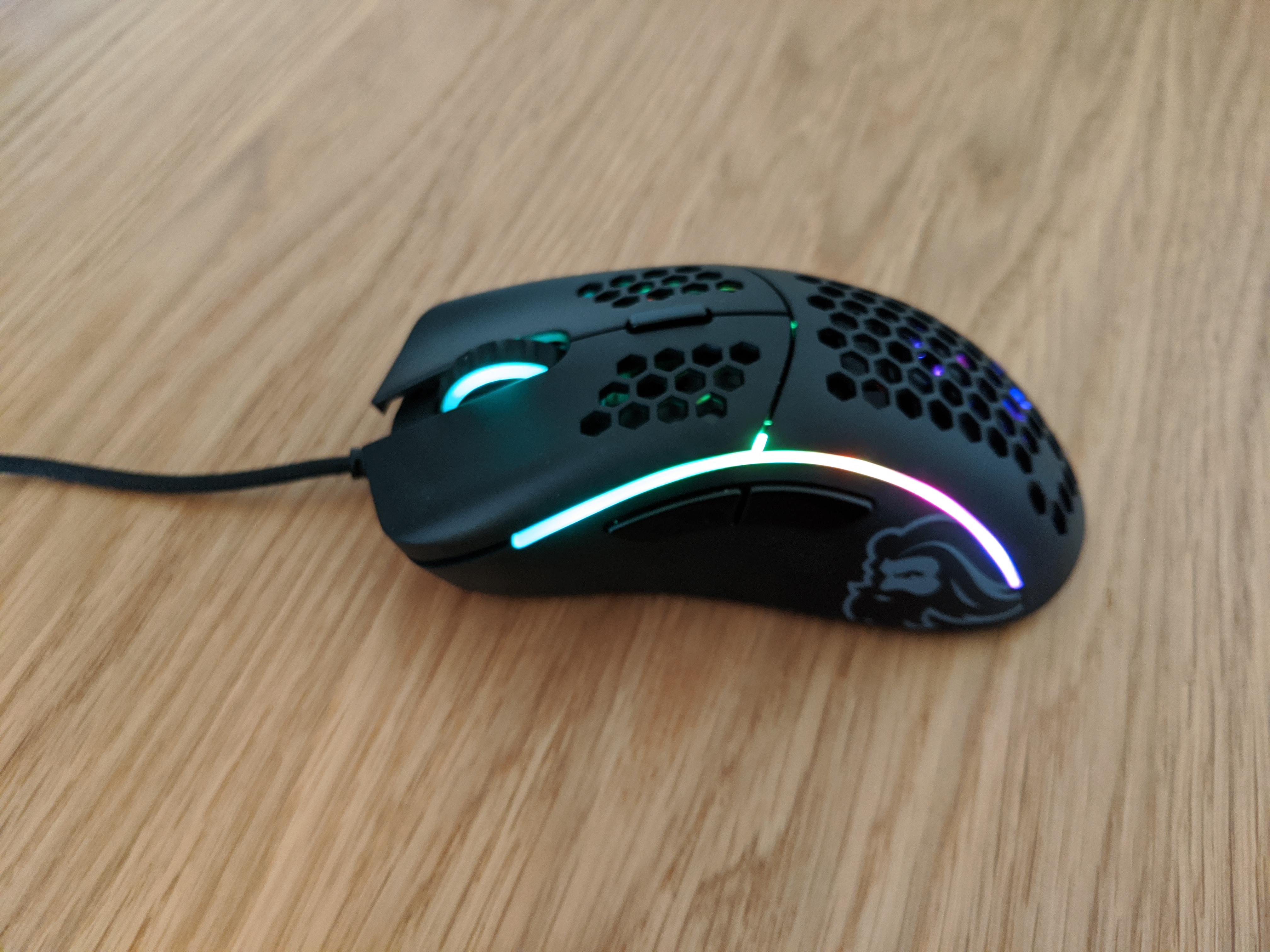
As with the Model O and Model O Minus, the Model D comes in four variants - matte black, gloss black, matte white and gloss white. We’re glad our review sample turned up in matte black trim; the glossy white model has a complexion only its mother could love. But if eschewing convention is your thing, the pallid version is at least an option.
This is a six-button layout obviously intended primarily for shooters, with two buttons conveniently located just above the thumb (it may seem an obvious choice, but so many gaming mice get the placement of these wrong and demand Twister-style contortions just to go back to the previous web page).
Like the Model O and Model O Minus, the Model D’s left and right mouse buttons (LMB and RMB) are slightly scalloped for comfort and sit above Omron-brand switches rated for… well, more clicks than you’ll probably ever exert on them -- 20 million, to be exact. The Model D’s buttons feel rigid (more so than the Model O) and didn’t move laterally at all in my experience, even with a fair amount of force applied to them.
The Model D has a different profile than the Microsoft Intellimouse-like Model O Minus. Our review subject is higher around the thumb and index finger and slopes off past the mouse wheel. Elsewhere it’s more of the same, albeit 10g heavier.
Get Tom's Hardware's best news and in-depth reviews, straight to your inbox.
The Model D stays light thanks to hexagonal holes across the base, rear and the back halves of the LMB and RMB. Compared to the smaller Model O Minus, these holes are slightly less densely packed and cover a smaller overall area of the mouse. I prefer the finer perforations of the O Minus, which offers a slightly more pleasant texture for resting the palm. But the differences didn’t impact the relative grippiness or comfort.
It’s also worth mentioning that the PCB within the Model D is coated to protect it from sweat or whatever else might get into the mouse’s innards over time. No need to worry about corroding the circuitry with your clammy palms.
This is an asymmetrical, ergonomic shape similar to most non-ambidextrous models, (like the Razer Basilisk, for example), and it filled more of my palm than other Glorious mice. The Model D reaches 42mm at its tallest point, compared with 37.5mm on the Model O and 36mm on the Model O Minus. That makes it a better fit for palm grip players, but its light weight makes it fit for claw or hybrid grips too. This writer’s personal preference lands on the Model O Minus, but I likely don’t have the same size hands as you.
Gaming Performance
This mouse is a great pick for titles like CS:GO, Quake Champions and other ‘pure’ shooters, where flick-aiming and spray compensation are required. The Model D’s PixArt PMW3360 sensor handled the load of such games smoothly and precisely during my testing. Meanwhile, the PTFE feet by G-Skates, meant to prevent snagging and encourage smooth movements, really did make a difference when I was making sharp, sudden changes in direction.
Four CPI modes provide the option of honing your aim in different games - perhaps a lower XPI in CS:GO and something higher for other genres, like strategies, MOBAs or RPGs. And with Glorious’ software you can set the exact value of each CPI. Unfortunately, the indicator light for the DPI mode is on the underside of the mouse, so it’s not practical to check where you’re at mid-game. Putting it on top, similar to the Corsair Nightsword RGB, would have been a fantastic solution here, albeit one that breaks up the clean lines and neat RGB zones a little.
I had no connection issues with the Model D, and none with the Model O Minus either. However, Glorious changed the wire from the Model O to the Model D to avoid any such issues. Where the Model O’s cord is disconcertingly baggy in an effort to prevent that annoying zig-zag of folds that occurs on braided cable mice after being cable-tied in their packaging, this new “Ascended” cord is slightly looser around the internal cabling than you’d find on other braided fabric cords, but much more slim-fit than the Model O or Model O Minus.
While the six-button layout does limit its potential for MMO players, there’s no reason it can’t be used as a Jack of all trades for pretty much everything else - particularly if you’re happy handling macros on your keyboard. A good sensor is a good sensor, and that experience carries over from battle royales, like PUBG (I didn’t get a shred of chicken dinner with the Model D, but hand on heart, that’s on me) to slower titles with less focus on outright performance, like Total War: Three Kingdoms, Metro Exodus or Hitman 2, (which is definitely better with a mouse and keyboard. Don’t @ me). The Model D shouldn’t be viewed as specialist equipment for professional (or aspiring pro) gamers.
Features and Software
Glorious has built a lightweight program in the Model D Software to match its lightweight mouse. It offers the essential tweaks in a small footprint (under 5MB) install with an easy-to-use user interface (UI). Unfortunately, it didn’t work out of the box.
For starters, there are separate programs for the Model O and Model D mice. This won’t affect the vast majority of users (because why would you have two?). But when you’re in the business of testing mice and already have software from Razer, Corsair, SteelSeries, Logitech and goodness knows who else lurking on your hard drive it's an annoyance.
More than that, though, the Model O software seemed to cause a conflict from running the Model D’s software. We spoke to Glorious, who told us that this is an issue with early models. It issued a firmware update that it said customers can ask for as well if they have the same issue.
Once working, the software offers RGB customization across three zones -- the mouse wheel and two strips along the sides -- along with CPI and polling rate adjustments. Thankfully, the out-of-the-box settings worked perfectly well and that’s a boon for anyone who wants to play without having to install more software.
Glorious keeps things clean and simple with its eponymous software, sticking to a single screen instead of the many tabbed affairs of its contemporaries. DPI sensitivity and color coding are taken care of on the right side of the app, including individual X and Y axis sensitivity, a granular touch not always offered elsewhere. In collapsible menus below that, you can set and save the Model D's RGB lighting zones’ colors and behavior. You can also make precision adjustments such as "debounce" (how quickly it looks for a second button click after the first) and polling rate. The middle image handles button mapping, and over in the bottom left you can save, import and export profiles.
Bottom Line
Except for a software issue we’re hoping will be fixed imminently, the Model D continues Glorious’ fine run of form in delivering lightweight, supremely usable FPS-focused mice.
The ergonomic design feels nice in the hand and shows what a difference the combination of a lightweight build and great quality PTFE feet can make. As a claw-grip gamer with smaller hands and an enduring love for the IntelliMouse profile, my personal preference still lies with the Model O Minus and the Model O’s shape, but those used to something more substantial underhand will get on famously with the Model D.
As the designers at Glorious obviously intended, gamers into flick-aiming, high-skill online shooters will get the most out of the Model D’s lightweight design, beautifully gliding PTFE feet and simple layout. If CS:GO, Quake Champions, Apex Legends and the like are installed on your SSD, consider the Model D.
MORE: Best Gaming Mice
MORE: Gaming Mice Reviews
MORE: Best RGB Mouse Pads
-
drawingpin Guys,Reply
Just so you're all aware, the price listed in the review from Amazon ($80) is due to re-sellers marking up the price. You can buy it straight from the manufacturer for only $50. Also of interest, I bought the Model D for work. I found that it was excellent to work with. Obviously you don't need the extra buttons etc, but the slightly larger size made it easier to handle and use for work,
Jim.
